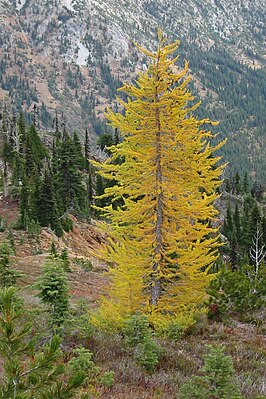Rock Mountain Larch
| Rock Mountain Larch | ||||||||||||
|---|---|---|---|---|---|---|---|---|---|---|---|---|

Mountain larch ( Larix lyallii ) in autumn |
||||||||||||
| Systematics | ||||||||||||
|
||||||||||||
| Scientific name | ||||||||||||
| Larix lyallii | ||||||||||||
| Parl. |
The rocky mountain larch ( Larix lyallii ) is a deciduous tree from the genus of larch ( Larix ) in the pine family ( Pinaceae ) that is native to northwestern North America. The specific epithet honors the Scottish doctor and naturalist David Lyall , who discovered the species.
description
Habitus
The rocky mountain larch is a deciduous tree that usually reaches heights of 20 to 30 meters, sometimes up to 25 meters and a chest height of 40 to 60 centimeters. In unfavorable, wind-exposed locations, the species grows mountain-like and is hardly larger than 20 centimeters. The open crown is wide and irregular in shape with long and often crooked branches. The branches hang down. The rocky mountain larch reaches a maximum age of 400 to 500 in individual cases up to 1,000 years.
Foliage
The needle-shaped leaves , standing in clusters of 20 to 30, are 2 to 3.5 centimeters long and dull blue-green. They are usually on the short shoots , only rarely are individual needles found on the long shoots. They have two small resin channels. In autumn, the needles turn a bright golden yellow before falling off. Depending on the location, the needles form from late May to mid-June and fall off from late September to early October.
Flowers, cones and seeds
The rocky mountain larch is single-sexed ( monoecious ) rarely hermaphroditic. Flowering takes place about a week before the leaves shoot. The approximately 1 centimeter long female cones are bright purple, sometimes green. The pollen has a diameter of 78 to 93 micrometers. Warm and dry weather is required for pollination. The cones, which are 2.5 to 4 centimeters long and 1.9 centimeters wide, are initially purple in color and dark brown until they ripen in the autumn of the flowering year. They have thin cone scales, the tips of which protrude far beyond the cones. The seed scales will be around 1.3 inches long and the cover scales around 1.6 inches long. The yellow to purple seeds are 4 millimeters long and 2.7 millimeters wide. They have wings that are around 6 millimeters in size. The thousand grain weight is 3.2 to 4.3 grams.
bark
The bark is initially more yellow-gray, with age it is dark-red-brown; it forms deep cracks and dissolves in small flaky plates. In contrast to the West American larch ( Larix occidentalis ), the bark is relatively thin. The bark of the annual twigs is finely hairy. Up to the third year it is bald, very rough and gray-black in color.
root
The rocky mountain larch forms a deep root system that is dominated by a taproot . The lateral roots form sinker roots that penetrate between rocks and anchor the tree.
Wood
The reddish-brown heartwood is surrounded by a narrow, cloudy white sapwood . Little is known about the physical and anatomical characteristics of wood .
Distribution and location
The home of the rocky mountain larch is in north-western North America in a relatively small area that is located on the border between the Canadian provinces of British Columbia and Alberta and the US states of Washington , Idaho and Montana . It grows there in the mountain ranges of the Rocky Mountains and the northern cascade range .
The rocky mountain larch is an extremely hardy light tree species. It occurs in the mountains at altitudes of over 2,300 meters. Occasionally, however, lower-lying avalanches and scree slopes are also settled. It needs annual precipitation of 1,020 to 1,140 millimeters to grow. In dry locations they can be found near streams or seepage water spots. This species is a specialist for acidic, stony and humus-poor soils that have arisen from granite or quartzite. Even soils that are covered with fly ash are populated. Stocks in basic locations are rare. Mixed stands are formed with Pinus albicaulis , the rocky mountain fir ( Abies lasiocarpa ) and the Engelmann spruce ( Picea engelmannii ).
Diseases and pests
The mountain larch is not seriously threatened by diseases or insect pests. A type of fungus of the genus Meria is considered a leaf parasite . The species Formes officinalis is considered to be the core rot pathogen . The species is said to be susceptible to the two rust fungi Melampsora medusae and Melampsora occidentalis .
use
The wood of the rocky mountain larch is hard and weather-resistant but is hardly used due to the inaccessible stocks. The ecological benefit that the species has in stabilizing steep slopes and preventing avalanches is enormous. It provides shelter and food for many animal species.
Systematics
In the natural habitat, the rocky mountain larch sometimes hybridizes with the West American larch ( Larix occidentalis ).
swell
- Schütt, Weisgerber, Schuck, Lang, Stimm, Roloff: Lexicon of Conifers . Nikol, Hamburg 2008, ISBN 3-933203-80-5 , p. 237-241 .
- Christopher J. Earle: Larix lyallii . In: The Gymnosperm Database. Retrieved September 6, 2012 .
- Description of Larix lyallii . Flora of North America (English)
Web links
- Larix lyallii inthe IUCN 2013 Red List of Threatened Species . Posted by: Farjon, A., 2011. Retrieved November 28, 2013.



